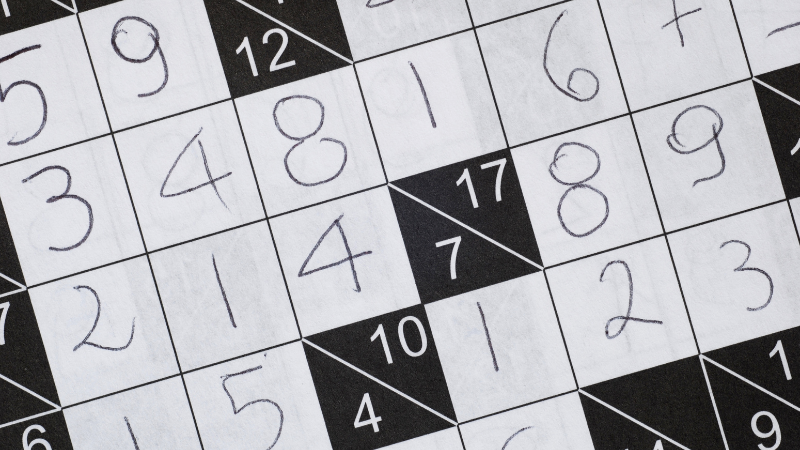Welcome to the fascinating realm of Kakuro puzzles – where numbers meet crossword-style grids to create a unique and stimulating challenge. If you’re a puzzle enthusiast seeking a delightful blend of math and logic, you’re in for a treat. In this comprehensive guide, we’ll delve deep into the intricacies of Kakuro puzzles, exploring their origins, rules, solving strategies, and the sheer joy they bring to millions around the globe.
Whether you’re a seasoned solver looking to sharpen your skills or a curious newcomer eager to embark on a captivating journey, join us as we unravel the mysteries of Kakuro and uncover the secrets to mastering this math crossword. Let’s dive in!
Key Takeaways:
- Kakuro puzzles blend logic skills and number-crunching with a crossword-like grid, each having a single solution.
- Filling in puzzles involves matching sums to provided clues without repeating any digit within a block.
- Kakuro offers varied grid sizes and levels of difficulty, appealing to a broad range of players and promoting healthy cognitive engagement.
The Basics of Kakuro
Kakuro puzzles are logic puzzles that combine elements of a crossword puzzle with number puzzles, resulting in a compelling blend of logic and numerical challenges. Often likened to Sudoku puzzles for their use of single digits and grid format, Kakuro presents a unique, language-independent challenge that has captured the interest of puzzle enthusiasts around the globe.
The aim of Kakuro is to fill all the white cells with numbers to satisfy the given sum in each corresponding clue, which is often referred to as a ‘cross sum’ or ‘run’. Each puzzle has a unique solution, relying purely on logic and mathematical skill.
Understanding the Grid
Kakuro grids are typically composed of white and black cells. The white cells are where you input numbers, while black cells contain the clue number for the sum of each horizontal block or vertical block adjacent to them. Each puzzle features a grid that can vary in size, offering numerous possibilities for puzzle enthusiasts. Typically, Kakuro puzzles use only numbers from 1 to 9, which means each number in a white cell is a single digit. Each set of white cells, separated by black cells, is considered an independent piece.
Rules and Objectives
The aim of Kakuro is to insert a digit from 1 to 9 into each white cell so that the sum of numbers in each horizontal block matches the clue number on the left side, and the sum of numbers in each vertical block matches the clue number on the top. No number may be repeated within a block, ensuring a unique solution for each puzzle.
Your objective is to fill all empty squares with the correct digits by employing a mix of logic, mathematical skill, and sometimes, even a bit of linguistic intuition. As a Kakuro veteran or even a first-timer, remember that Kakuro puzzles are independent pieces of the larger picture, where the sum-clues and the number of cells guide you to find the only possible combinations, a healthy way to stretch your mental muscles.
Strategies for Solving Kakuro Puzzles

To excel in solving Kakuro puzzles, you need a blend of analytical thinking and systematic approach. Understanding common strategies will enhance your skills, whether you’re a beginner or an expert.
Puzzle Layout Analysis
When you start a Kakuro puzzle, your initial focus should be on analyzing the puzzle layout. Identify the white cells and the black cells containing the clues. Each white cell can only contain a single digit, and the number in each black cell indicates the sum of the digits in the straight line that follows it, either across or down. Consider the number of cells in each row and column; this can limit the possible values each cell can hold. For smaller puzzles, a grid analysis can provide swift solutions through pure logic; for larger grid sizes, a more complex approach might be required.
Common Patterns and Techniques
One of the classic techniques in solving Kakuro puzzles is looking for unique solution sets. A list of number sets with corresponding clue numbers for each possible combination, often called ‘magic blocks,’ can significantly streamline the process. For instance, if a block must sum to 16 across three cells, the only possible combinations are {7,8,1}, {6,9,1}, {5,9,2}, {4,9,3}, {7,6,3}, {8,5,3}, {8,6,2}, and {7,5,4}. Recognizing these unique sets as the only combination for the given sum narrows down your choices. This is akin to Sudoku puzzles, where patterns help reduce possibilities to only number choices that make sense.
- Common Sums: For quick reference, keep a list of number sets handy.
- High-Sum Clues: With a high clue number in a small number of cells, only a few permutations exist. Use these ‘anchor points’ to build around.
- Low-Sum Clues: These usually have fewer permutations and are a good starting point.
- Single Options: Sometimes, a cell in the puzzle can only house one digit as its solution; it’s your ‘magic block’ or ‘pivot point’.
Tips for Beginners and Experts
Whether you’re a Kakuro veteran or it’s your first time venturing into this compelling blend of logic and number puzzles, remember that patience and practice are key.
- Beginners: Start with easy puzzles and grasp the basic techniques. Notice patterns like ‘cross sums’ that emerge from the sum of each horizontal block and the sum of each vertical block intersecting at one cell.
- Experts: Tackle puzzles with endless variations and different difficulty levels. Employ a mix of short-term memory for recent permutations and deductive skills for more challenging layouts.
Here are some practical tips to enhance your puzzle-solving prowess:
- Vertical and Horizontal Clues: Always compare the vertical clues to the horizontal clues. The intersection often provides ‘cross sums’ insights.
- Number Combinations: Familiarize yourself with common number combinations for the classic Kakuro sums.
- Logic First: Before writing down possible digits, use logic to eliminate impossibilities.
- Consistent Progress: Always cross off numbers you have ruled out to narrow down the list of candidates, leading to a streamlined process in solving the rest of the puzzle.
Variants and Different Forms of Kakuro
Kakuro, also known as cross sums or kasan kurosu, presents a compelling blend of logic and number puzzles. It draws from the elements of a crossword puzzle and numerical challenges, offering variants that range from classic grids to modern apps.
Traditional versus Modern Variations
Modern variations of Kakuro introduce streamlined processes and digital conveniences. Smartphone Kakuro apps developed by tiny game studios offer a premium game experience, allowing you to play Kakuro puzzles at different difficulty levels. These apps often come with features like a list of number sets that can fit into self-contained blocks, helping both the Kakuro veteran and the average person in solving puzzles.
Worldwide Kakuro Variations
Kakuro enjoys a wide range of interpretations and styles around the globe, following in the footsteps of the worldwide sudoku success. Different from the classic puzzle, variations such as diamond Kakuro, heart Kakuro, and round Kakuro provide unique grid shapes and layouts which can challenge and develop cognitive and deductive skills in different ways.
In Japan, multi Kakuro involves multiple Kakuro grids which are interconnected, making it a fabulous way to test your ability to switch between independent pieces of puzzles. Meanwhile, holey Kakuro adds a special situation by including cells that can not contain any number, thus adding an extra layer of complexity. Advanced players may enjoy Conceptis Kakuro available online, renowned for their unique sets that ensure a single solution and emphasize pure logic.
Across the board, irrespective of the variant, Kakuro offers a healthy way to exercise your brainy games muscle with its endless variations and challenging numerical-crossword puzzles. Whether you indulge in a Kakuro puzzle book or tackle free Kakuro puzzles online, your logic skills and ability to find the only combination that fits both horizontally and vertically will surely be sharpened.
Cultural Impact and Resources
Kakuro, similar to its cousin sudoku, has carved its niche in the puzzle game world, blending numerical challenges with elements of a crossword puzzle. This section explores its influence on culture and resources available for enthusiasts.
Kakuro in Popular Culture
The compelling blend of logic that Kakuro offers has secured it a place in the hearts of puzzle aficionados. Part of Kakuro’s charm is its addictive language-independent logic puzzles which, like Sudoku puzzles, challenge your numerical and deductive skills. After stepping into the footsteps of the worldwide sudoku success, kakuro has become a staple in brainy games sections of newspapers and puzzle publications, allowing players to test their mental muscles in a healthy way. Some TV shows and game caretakers have also adopted Kakuro, presenting it as a fun segment in programming, thus introducing it to a broader audience.
Books and Apps
Books: When seeking Kakuro puzzles, a simple search will yield various titles rife with grids that demand the solver to employ logic skills. A well-received Kakuro puzzle book may include a list of number sets that can help in determining the only possible combinations, streamlining the process tremendously.
Apps: In today’s digital age, numerous applications are available to play Kakuro on-the-go. Look out for apps that provide a premium game experience, with intuitive interfaces and endless variations of grid sizes to keep things fresh.
Whether you are a Kakuro veteran or someone just discovering this classic puzzle, the available body of literature and digital applications can provide you with an endless supply of challenges. Sharpen your mathematical skill and have fun while exerting your brain in what many consider a fabulous and rewarding part of one’s daily routine.
FAQs
What are Kakuro Magic Blocks and how are they used?
Kakuro Magic Blocks are self-contained blocks, a sort of linguistic intuition tool showing the only possible combinations of small numbers that fit a given sum in a certain number of cells. For instance, if a vertical definition indicates the sum is 16 across two cells, the magic block list of number sets might suggest 7 and 9, as they are the only combination that meets the given number sum. This facilitates a more streamlined process for filling out the more challenging areas of Kakuro grids.
Can you compare the difficulty level of Kakuro with Sudoku?
Kakuro can be considered a good game for those who relish a challenge beyond Sudoku puzzles, providing a compelling blend of logic and numerical challenges. Whereas Sudoku is restricted to ensuring the only number from 1 to 9 appears once in every row, column, and grid, Kakuro requires the solver to arrive at a unique solution using addition and the limitation of using each only digit once within each sum total.
The difficulty of Kakuro mostly hinges on the variety of numerical combinations and the size of the puzzle, making it a fabulous way to test both short-term memory and deductive skills.
Where can one find Kakuro puzzles to solve for free?
You can find Kakuro puzzles to solve for free on various puzzle websites, online forums, social media groups dedicated to puzzles, puzzle mobile apps, and in puzzle books or magazines that offer online versions or printable puzzles.
Additionally, some newspapers may also feature Kakuro puzzles in their puzzle sections, either in print or on their websites. Simply searching for “free Kakuro puzzles” online will yield numerous results and options for you to choose from.
Conclusion: Embrace the Challenge, Master the Puzzle
As we reach the end of our exploration into the world of Kakuro puzzles, it’s clear that these captivating brain teasers offer far more than just an enjoyable pastime. From their humble origins to their widespread popularity today, Kakuro puzzles continue to engage and challenge minds of all ages.
Armed with a solid understanding of the rules, techniques, and strategies we’ve discussed, you’re well-equipped to tackle Kakuro puzzles with confidence and finesse. Remember to approach each puzzle with patience, persistence, and a willingness to embrace the challenge.
Whether you’re seeking a mental workout, a moment of relaxation, or simply a fun way to pass the time, Kakuro puzzles provide a rewarding experience that’s both stimulating and satisfying. So, gather your pencil and grid, and let the adventure begin anew with each puzzle you solve.
Thank you for joining us on this journey through the captivating world of Kakuro. May your future solving endeavors be filled with joy, accomplishment, and countless “Aha!” moments. Happy puzzling!









